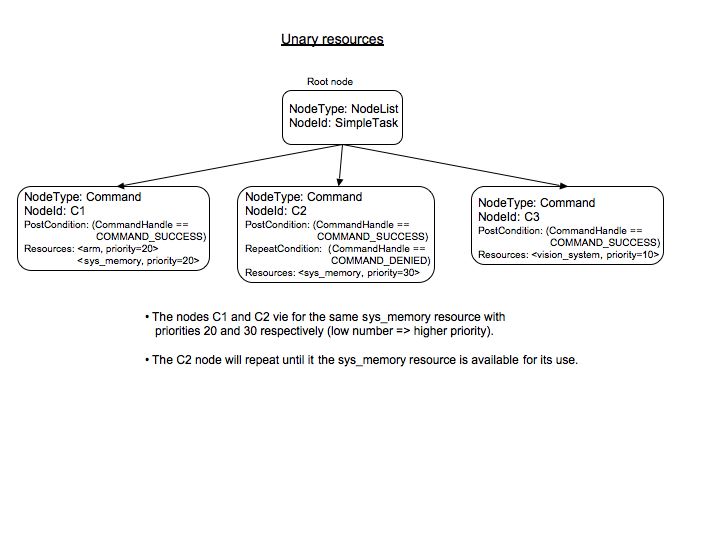Simple Unary Resources¶
13 Jan 2023
This example demonstrates how PLEXIL handles unary command resources, and how node priority is used to resolve contention for a shared resource.
The example plan can be found at plexil/examples/resources/resource1.ple, its associated resource file at plexil/examples/resources/resource1.data, and a simulation script at plexil/examples/resources/scripts/resource1.pst. The debug trace from running this example will be helpful in uderstanding how resource arbitration works.
This example makes use of 3 unary resources, arm, sys_memory,
and vision_system. Each resource has a maximum quantity of 1.0.
Three Command nodes, C1, C2, and C3, are scheduled to
start concurrently. Each node’s command has its own resource
requirements:
Node
C1commandc1requires resourcesarmandsys_memoryNode
C2commandc2requires resourcesys_memoryNode
C3commandc3requires resourcevision_system
Each node has been assigned a priority:
Node
C1has priority 20Node
C2has priority 30 (the value of variablemem_priority)Node
C3has priority 10 (the value of variablevision_priority)

At the first macro step, the resource arbiter receives all 3 requests, and considers them in priority order: best (numerically smallest) to worst (numerically larger).
Node C3 and its command c3 at priority 10 are considered
first. The vision_system resource is available, so the resource
arbiter allocates it and accepts command c3.
Next, the arbiter considers node C1 and its command c1 at
priority 20. The requested resources arm and sys_memory are
both available, so the arbiter allocates both resources and accepts
command c1.
Node C2 and command c2 at priority 30 are considered last.
The request for sys_memory cannot be satisfied, as all of this
resource is already allocated to command c1. So the arbiter
denies its request.
The result is that the PLEXIL Executive issues commands c1 and
c3, and sets the command handle of c2 to COMMAND_DENIED.
This causes node C2 to transition to ITERATION_ENDED. Because
the PostCondition on node C2 evaluates to false, its outcome
is FAILED and its failure type is POST_CONDITION_FAILED.
At the next macro step, the RepeatCondition on node C2 makes it
eligible for execution. But command c1 has not finished
executing, so the arbiter rejects command c2 again.
At the next macro step, command c1 has finished, and the arbiter
releases its resources arm and sys_memory. Node C2 and
command c2 are eligible for execution again. This time, because
sys_memory is available, the arbiter allocates it, and accepts
c2 for execution.
The entire PLEXIL plan is shown below.
Integer Command c1;
Integer Command c2;
Integer Command c3;
SimpleTask:
Concurrence
{
C1: {
Integer returnValue = -1;
EndCondition returnValue == 10;
PostCondition C1.command_handle == COMMAND_SUCCESS;
Resource Name = "sys_memory", Priority = 20;
Resource Name = "arm", Priority = 20;
returnValue = c1();
}
C2: {
Integer mem_priority = 30;
Integer returnValue = -1;
RepeatCondition C2.command_handle == COMMAND_DENIED;
PostCondition C2.command_handle == COMMAND_SUCCESS;
EndCondition returnValue == 10;
Resource Name = "sys_memory", Priority = mem_priority;
returnValue = c2();
}
C3: {
Integer returnValue = -1;
Integer vision_priority = 10;
PostCondition C3.command_handle == COMMAND_SUCCESS;
EndCondition returnValue == 10;
Resource Name = "vision_system", Priority = vision_priority;
returnValue = c3();
}
}